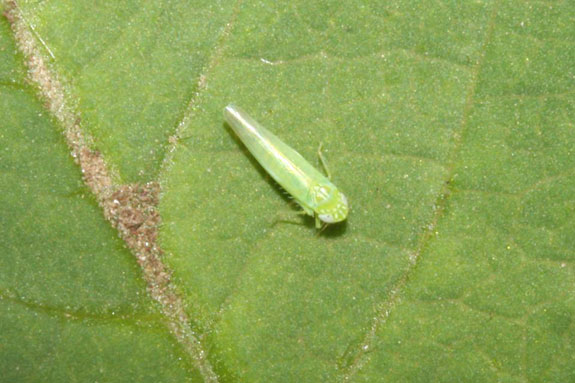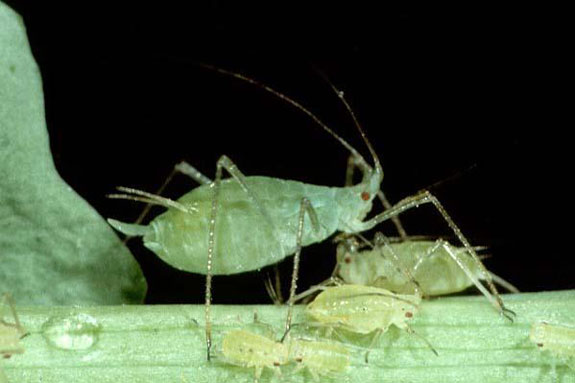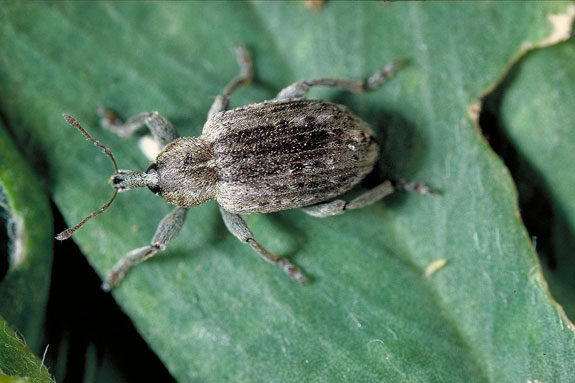Alfalfa weevil
Growers already are seeing significant alfalfa weevil pressure on some of the alfalfa stands in many areas. Alfalfa weevil is the first damaging insect to rob alfalfa yields with its early feeding.
Young larvae damage alfalfa by feeding on terminal buds while larger larvae feed on the leaflets. The feeding by the older larvae causes the most damage, leading to skeletonization and bronzing of the leaves in spring. Under severe pressure, complete defoliation can occur.
Although alfalfa weevil pressure generally is limited after first cut, scouting continues to be important. Growers should revisit fields that had significant leaf defoliation due to alfalfa weevil on first cut. This includes looking at crown buds to make sure they are forming and growing normally and are not being fed on by weevil larvae.
Potato leafhopper
Potato leafhopper (PLH) pressure is light to date, but with dryer weather, it is expected to build. Scouting will be important on second growth alfalfa.
PLH is one of the most common and destructive insects affecting alfalfa in North America. Migration of leafhoppers occurs during the spring, bringing adults to the northern and northeastern states where subsequent buildup of large populations occurs.
The first indicator of PLH stress on alfalfa is the V-shaped yellowing at leaf tips. When severe or prolonged stress occurs, leaves turn reddish or bronze and plants stop growing. In addition, maturity may be delayed, and leaf growth slows as a result of leafhopper stress.
Forage yield is reduced following attack by this insect when compared to insect-free plants. Because alfalfa is a perennial, multiple-cut crop, the effects of severe PLH damage can carry over into subsequent harvests and make the plant more susceptible to other diseases or environmental stresses. It is not uncommon to first-cut yield depression in the growing season following a heavy leafhopper infestation.
Once the visible symptoms of hopperburn and plant stunting become evident, it is too late for corrective action. Economic damage is likely and treatment options are limited. A combination of control strategies is required to effectively minimize the damage caused by leafhoppers in alfalfa.
Management options require timely scouting, and may include pesticidal control or early harvest of infested stands. Growers should also consider PLH resistant varieties if timely and effective scouting and spraying have been too much of a challenge to obtain adequate control.
Pea aphid
Another high-pressure insect affecting some areas is the pea aphid. Dry weather is expected to promote the continued population growth of this alfalfa insect pest. It has been seen in regrowth of alfalfa in the southern part of Wisconsin.
Pea aphids feed on alfalfa and inject a toxin that stunts growth, reduces yield and may even kill plants. Damage also can reduce alfalfa’s feed value. This is because a black fungus can grow on the honeydew excreted by the aphid, reducing palatability to livestock. Damage is more severe on short stands than on taller alfalfa.
When the aphids infest alfalfa, proper timing of cutting (during the early-bloom stage) reduces the aphid population by exposing it to direct sun. In addition, proper and effective crop management results in a vigorous stand that is less prone to aphid attack. Planting resistant varieties and encouraging populations of natural enemies also can be very important in managing the pea aphid.
Stem nematode
This nematode is a serious pest of alfalfa in parts of the western United States. It is common in parts of the western U.S., and is most serious in fields with heavy soils and heavy rainfall or irrigation.
With stem nematode, the stems, stem nodes, and crown buds of infected plants become swollen. Heavily infected plants may have curled and distorted leaves, stems may become white, then blacken and die, or the entire plant may be killed. Severe infections also can reduce stem numbers and predispose plants to winterkill and other diseases.
To combat stem nematode, plant alfalfa varieties with high resistance to stem nematodes. Varieties with resistance slow nematode reproduction and/or are more tolerant of their feeding. In addition, planting two or three year rotations out of alfalfa to a non-host crop such as corn, small grains or beans can reduce populations to low levels.
Fields can be infested quickly, so efforts should be made to avoid contamination of fields with infested irrigation water, soil, and contaminated plant debris.
Scouting fields on a regular basis can help growers address these and other insect issues to help ensure a high-quality, high-yielding alfalfa crop. FG
PHOTOS
Photos courtesy of Kansas State University

Robin Newell
Forage Business Manager
Pioneer Hi-Bred










